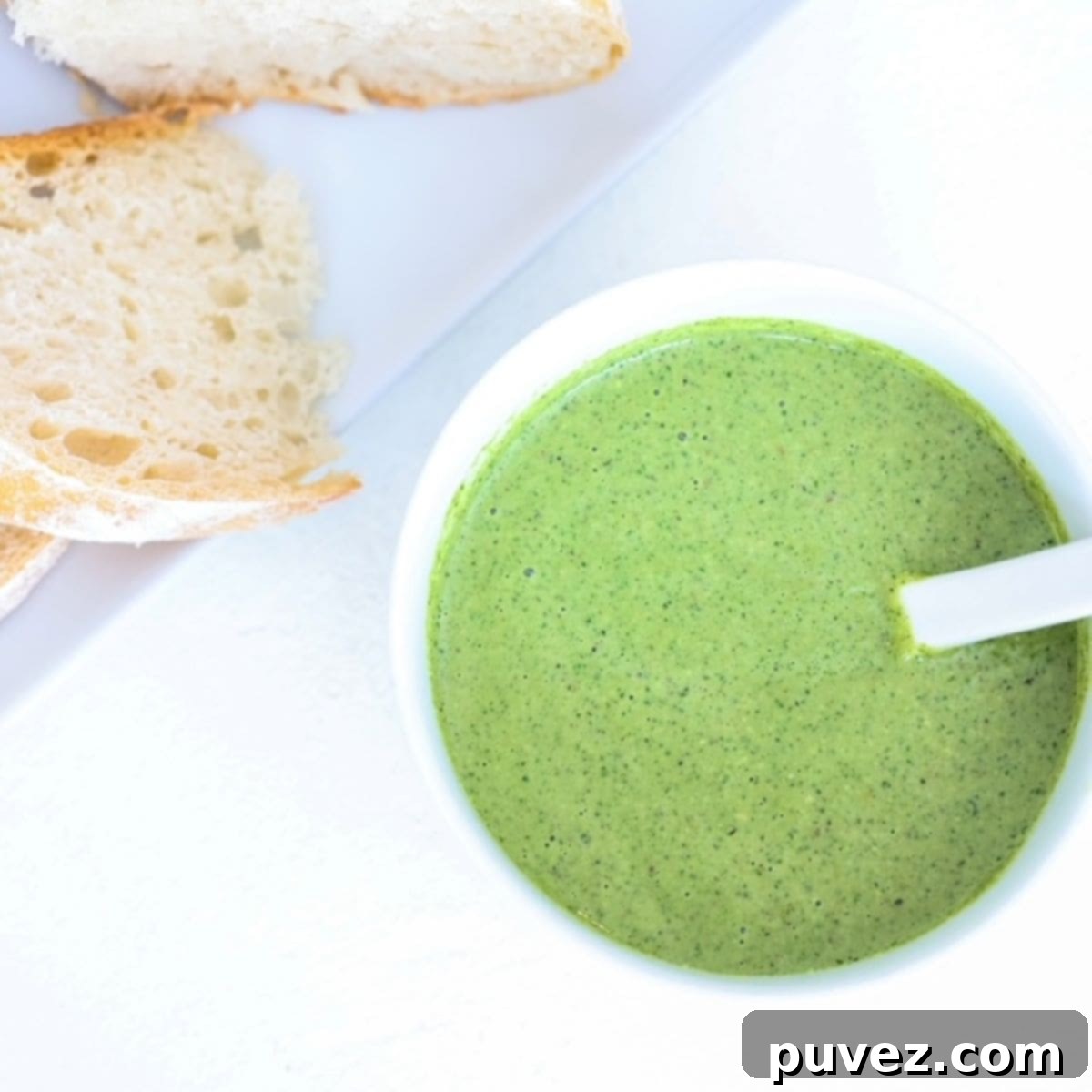Homemade 5-Minute Pistachio Pesto: Your New Favorite Easy & Flavorful Sauce
Discover the secret to an incredibly delicious, vibrant Pistachio Pesto! Made with just a handful of simple, fresh ingredients, this versatile sauce comes together in a mere 5 minutes. Forget bland, store-bought alternatives – this homemade pesto bursts with a fresh, nutty flavor and a perfectly creamy texture that will elevate any meal. It’s not just a sauce; it’s a game-changer for quick weeknight dinners and gourmet-level entertaining.
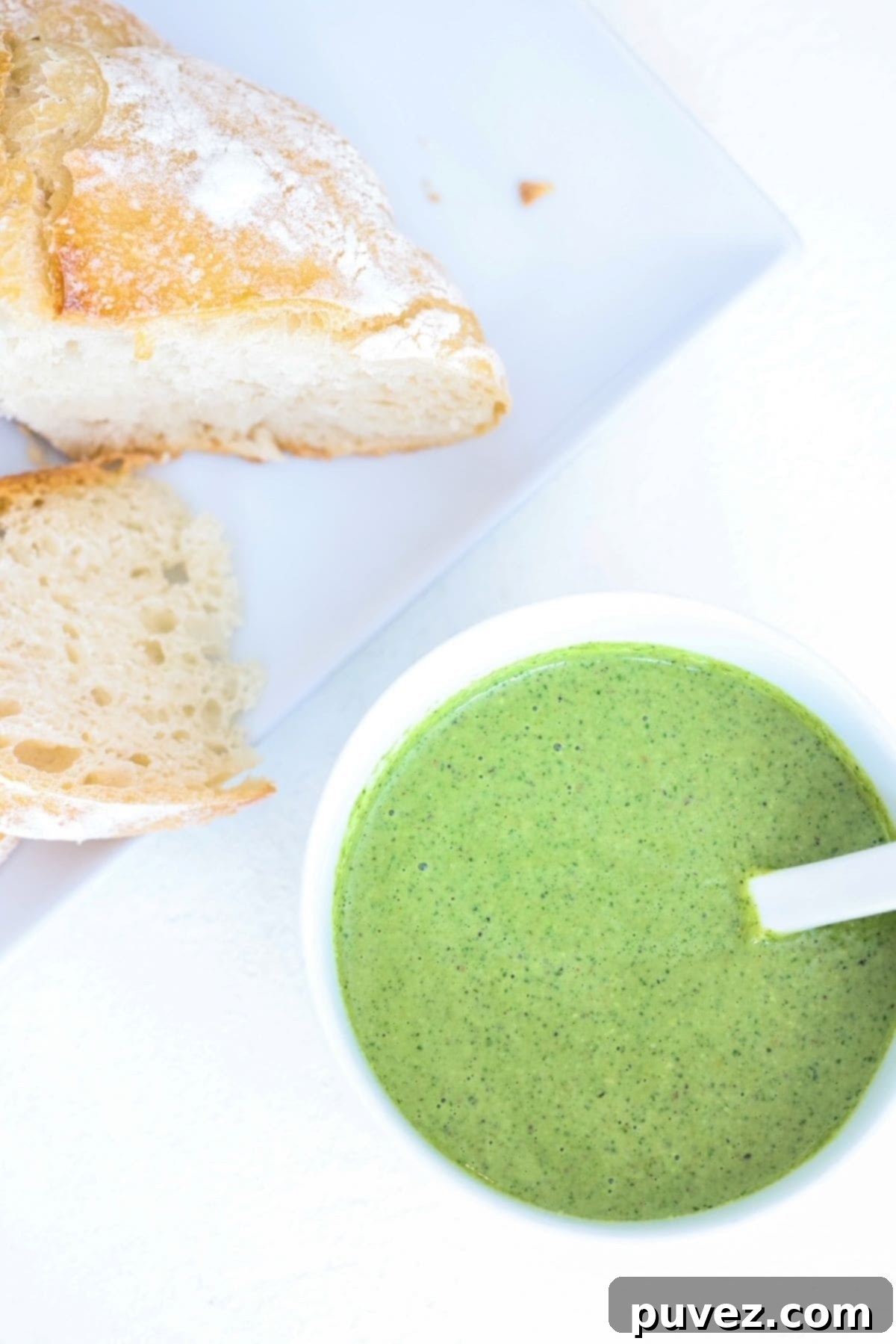
I’ve always had a deep appreciation for traditional basil pesto, but my culinary journey has been inspired by a desire to explore more practical ingredients while intensifying the flavors. This journey led me to discover that the world of pesto extends far beyond just pine nuts and basil. There are countless delicious variations waiting to be created!
My first breakthrough was creating a truly delicious homemade pesto without pine nuts that still captured the essence of classic basil pesto. This opened up a world of possibilities, encouraging me to experiment with different nuts and herbs. Did you know you can use fresh flat-leaf parsley or cilantro instead of basil? The sheer variety of pesto options is truly exciting! 😍
For this particular recipe, I decided to highlight pistachio nuts. Not only do I find pistachios more readily available and often more affordable than traditional pine nuts, but they also introduce a delightful, slightly sweet, and earthy flavor profile. This, combined with their unique texture, adds an exciting twist to this already incredible pesto sauce. I am genuinely thrilled for you to try this unique pistachio pesto and experience its magic!
[feast_advanced_jump_to]
Why You’ll Fall in Love with This Pistachio Pesto Recipe
This pistachio pesto isn’t just another sauce; it’s a culinary revelation that combines convenience with gourmet taste. Here’s why it’s destined to become a staple in your kitchen:
- Effortlessly Easy Recipe: You’re just five minutes away from a vibrant, flavorful sauce! This recipe requires minimal effort, asking for only a handful of common ingredients and the simple convenience of a blender or food processor. It’s perfect for busy weeknights when you want something homemade and delicious without the fuss.
- Simple, Wholesome Ingredients: No need for exotic spices or hard-to-find items. All the fresh ingredients you need—like fragrant basil, rich pistachios, pungent garlic, and zesty lemon—are easily found in the produce section of your local grocery store. Extra virgin olive oil is a pantry staple, and grated Parmesan cheese is readily available at most markets or in bulk at places like Costco.
- Brilliant for Meal Prep: If you find yourself with an abundance of fresh basil, this pesto recipe is the perfect solution for preserving its freshness and flavor. Make a large batch and utilize an ice cube tray to freeze individual portions. This smart meal prep strategy ensures you have ready-to-use, homemade pesto cubes that can be easily defrosted for quick meals later in the year, even on your busiest days.
- Incredibly Versatile Sauce: This isn’t just for pasta! Our recipe strikes the perfect balance, using just enough olive oil and a touch of water to create a light yet creamy pesto sauce. This makes it incredibly adaptable. Use it as a flavorful base for your ‘go-to’ pesto pasta dish or stir it into any of your favorite pasta preparations. Beyond pasta, drizzle this vibrant green sauce onto bruschetta, elevate a Caprese salad, transform simple avocado toast, enhance a margherita flatbread, or add a burst of flavor to wholesome ancient grain bowls. The possibilities are truly endless!
Dietitian’s Tip: Embrace Flexibility in Your Cooking
As a dietitian, I often emphasize that recipes are a fantastic guide, but they are also wonderfully flexible. Don’t hesitate to adapt ingredients based on what you have on hand, to meet specific dietary needs, or to simply enhance the nutritional profile for yourself or your family.
For example, if you have a child who needs to gain weight, you can easily boost the calorie content of this pesto. Instead of using water, substitute it entirely with extra virgin olive oil, or simply stir in an additional tablespoon or two of olive oil directly into your child’s individual serving. This small adjustment can significantly increase calorie density without compromising flavor.
Similarly, if you’re short on fresh basil or want to introduce more greens, feel free to substitute a portion of the basil with other leafy greens. Baby spinach leaves or even curly kale can work beautifully, maintaining a vibrant green color and adding a nutritional boost. While the flavor profile will naturally shift slightly, I assure you, it will still result in a remarkably delicious and wholesome pesto. Culinary creativity in the kitchen is key!
Key Ingredient Notes for Perfect Pistachio Pesto
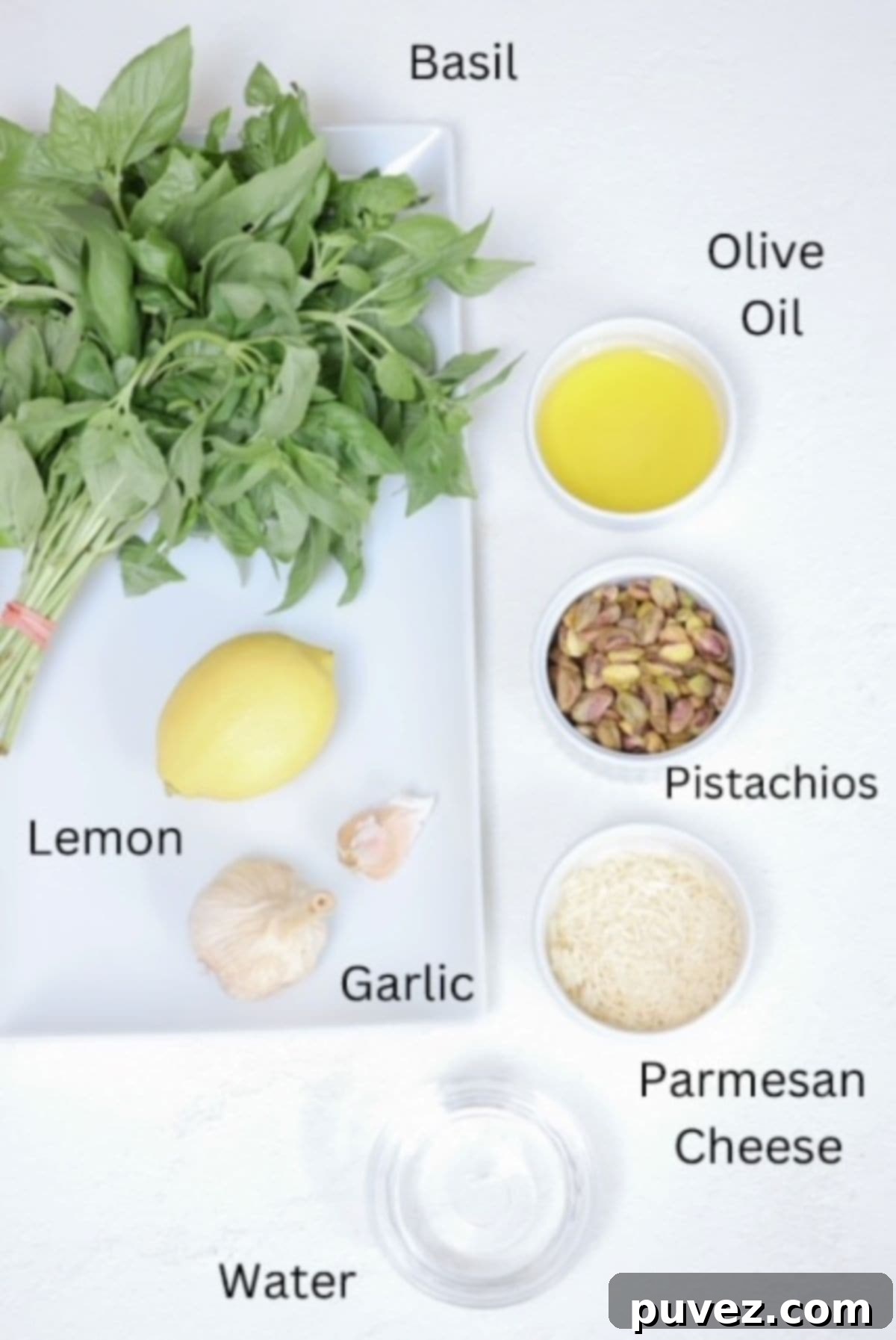
- Fresh Basil Leaves: The heart of any good pesto! This pistachio pesto recipe, like its traditional counterpart, relies on the vibrant, aromatic flavor of fresh basil. For the best results, ensure your basil leaves are bright green and fragrant. If you find yourself with slightly less basil than needed, you can successfully substitute a portion with baby spinach or fresh flat-leaf parsley. These alternatives maintain a similar texture and a mild flavor that won’t overpower the pesto.
- Pistachios: While many pistachio pesto recipes suggest raw pistachios, I’ve found great success with both raw and roasted, salted pistachios. Raw pistachios will yield a slightly brighter green color and a more delicate, earthy flavor. Roasted and salted pistachios, on the other hand, offer a deeper, more robust, and slightly saltier taste. Feel free to use what you have available – both versions are delicious! Just be mindful of the added salt if using roasted and salted nuts when adding extra seasoning.
- Garlic: Fresh garlic cloves are non-negotiable for that essential, pungent garlic flavor that truly makes pesto sing. While you technically can omit it if you’re not a fan, I highly recommend including at least one fresh clove to achieve a balanced flavor profile. Minced garlic from a jar won’t quite deliver the same fresh punch.
- Lemon: Inspired by the bright, zesty notes in Trader Joe’s vegan kale pesto, fresh-squeezed lemon juice is a crucial ingredient here. It adds a wonderful zing that cuts through the richness of the oil and nuts, elevating the overall flavor of this delicious pesto. For an even more intense citrus aroma, you can zest the lemon before squeezing its juice. However, note that some people find lemon zest can leave a slight aftertaste, so this step is entirely optional.
- Olive Oil: Always opt for high-quality extra-virgin olive oil. Its fruity, slightly peppery notes are integral to the classic pesto flavor and contribute significantly to the sauce’s silky texture. The better the olive oil, the better your pesto will taste.
- Salt: Salt is essential for bringing out all the flavors. If you’re using raw or unsalted pistachios, you’ll likely need about ½ teaspoon of salt. If using roasted and salted pistachios, start with just a pinch and taste before adding more, as the nuts will already contribute significant sodium.
- Black Pepper: A touch of freshly ground black pepper adds a subtle warmth and a gentle bite, complementing the other flavors beautifully.
- Water: This might seem unconventional for pesto, but a small amount of warm water helps achieve a lighter, creamier consistency without making the pesto overly oily. It also helps the ingredients emulsify more smoothly.
How to Craft Your Perfect Pistachio Pesto
Creating this incredibly fresh and flavorful pistachio pesto is astonishingly simple and takes mere minutes. Here’s a quick overview of the process. For precise measurements and detailed step-by-step instructions, please scroll down to the full recipe card below.
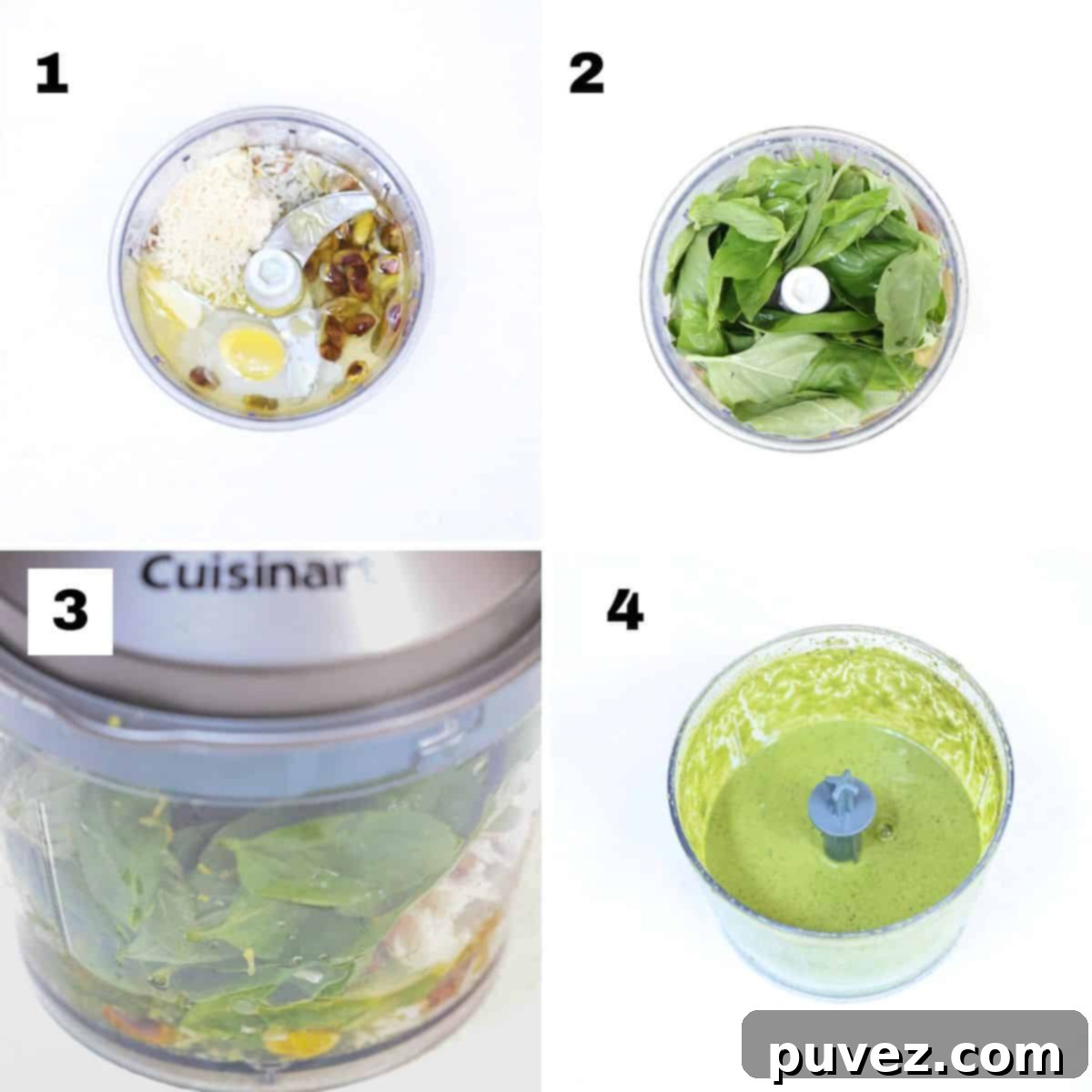
- Combine Ingredients: Begin by adding all the measured ingredients into the bowl of your food processor or blender. For optimal blending, ensure that the garlic cloves are placed closer to the blades, and the lighter basil leaves are added last, sitting on top.
- Blend to Perfection: Secure the lid and blend or pulse the mixture. Continue until you achieve a beautifully smooth and creamy consistency that suits your preference. You might need to scrape down the sides occasionally to ensure everything is incorporated evenly.
And just like that, your homemade pistachio pesto is ready to enjoy!
Creative Ways to Serve Your Homemade Pistachio Pesto
Once you’ve made a batch of this vibrant pistachio pesto, you’ll find yourself looking for every opportunity to use it. Its rich, nutty, and herby flavor profile makes it incredibly versatile. Here are some of my favorite ways to enjoy this delicious sauce:
- As a Flavorful Dip with Bread: Recreate that authentic Italian restaurant experience right at home! Serve your pesto in a shallow bowl, perhaps with a drizzle of extra olive oil, alongside warm, crusty bread like sourdough or focaccia. It’s the perfect pre-meal appetizer or a simple, satisfying snack.
- Elevate Your Pasta Dishes: This is arguably the most classic way to enjoy pesto. Use it as a delightful alternative to traditional marinara sauce for a unique pistachio pesto pasta. Or, try our absolute favorite: tortellini with pesto and chicken, a quick and satisfying meal. It also pairs wonderfully with gnocchi, ravioli, or any long pasta.
- Pair with Pan-Seared Salmon: For a quick and elegant meal, spread a generous spoonful of this pesto over your cooked salmon. This recipe suggests adding pesto to air-fried salmon just before it finishes cooking, allowing the flavors to meld beautifully.
- Gourmet Avocado Toast: Transform your everyday avocado toast into something extraordinary. I discovered this idea at a local restaurant. Drizzle your homemade pistachio pesto over mashed avocado, and consider adding roasted beets or microgreens for a truly ‘superfood toast’ experience. It’s a fantastic way to add an extra layer of flavor and nutrition.
- Boost Ancient Grain Bowls: Inspired by the healthy and delicious offerings at True Food Kitchen, this pesto is fantastic in grain bowls. Mix it into a base of quinoa, rice, and farro, then top with roasted sweet potatoes, savory portobello mushrooms, crisp snap peas, charred onions, and creamy avocado. The pesto ties all the components together with its fresh, earthy notes, creating a balanced and fulfilling meal. Check out their ancient grain bowl menu for more inspiration!
- Sandwiches and Wraps: Spread a thin layer of pesto on your bread or tortilla to add an instant flavor upgrade to any sandwich, panini, or wrap.
- Pizza Base: Use it as a vibrant green base for homemade pizzas or flatbreads instead of tomato sauce.
- Roasted Vegetables: Toss roasted vegetables like asparagus, broccoli, or bell peppers with a spoonful of pesto for an easy side dish.
Helpful Tips for Your Best Pistachio Pesto
Achieving the perfect homemade pesto is easy, but a few insider tips can make all the difference in texture and flavor. Keep these pointers in mind for your next batch:
- Achieving a Smoother Texture: If you’re using a food processor, your pesto might have a slightly grittier texture due to the nuts. While delicious, if you prefer a silky-smooth pesto, consider transferring it to an immersion blender or a high-speed upright blender for a final quick blitz. This will help break down the nuts and basil into an ultra-fine paste.
- Adjusting Consistency: Pesto consistency is a matter of personal preference. If you find your pesto too thick and desire a thinner, more pourable sauce, gradually add an additional tablespoon of water or extra virgin olive oil. Do this one tablespoon at a time for every quarter cup of pesto, blending after each addition until you reach your desired texture.
- Blender Loading Order (Upright Blenders/Food Processors): For upright blenders or food processors with blades at the bottom, place the harder ingredients like garlic cloves first. This ensures they are finely minced. Add the pistachios next, followed by the cheese, and finally, the softest ingredients like basil leaves on top. This order allows the blades to efficiently process all ingredients.
- Blender Loading Order (Inverted Blenders): If you’re using a blender where the container is inverted onto the base (like some personal blenders), reverse the order. Place the basil leaves first, followed by the softer ingredients, and finally, the garlic cloves and nuts last. This ensures the harder ingredients are closest to the blades once inverted, allowing for better processing.
- Lemon Zest – An Optional Touch: Adding fresh lemon zest can provide an extra layer of citrus aroma to your pesto. However, in my experience, I sometimes find that lemon zest can leave a subtle, slightly bitter aftertaste in this particular recipe. If you don’t mind this nuance and enjoy a very bright, citrusy flavor, then absolutely go for it! Otherwise, sticking to just the lemon juice is perfectly fine.
- Raw vs. Roasted Pistachios: Don’t stress if you can’t find raw pistachios. I tested this recipe thoroughly with both raw and roasted pistachios because raw ones were hard to come by in my local stores. While I noticed a slight difference in the final color (raw yields a brighter green), both versions tasted fantastic! Roasted pistachios offer a deeper, more pronounced nutty flavor, while raw ones are milder. Choose what’s convenient or what flavor profile you prefer.
Frequently Asked Questions About Pistachio Pesto
Absolutely! Making pesto ahead of time is a fantastic way to save time. To keep your pesto tasting fresh and prevent browning (oxidation), cover the surface of the pesto with a very thin layer of extra virgin olive oil before refrigerating. This creates a barrier against the air.
If you plan to use it within a few days, store it in an airtight container with a tight-fitting lid in the refrigerator. For best results, choose a container that is just large enough to hold the pesto, minimizing the air trapped between the pesto and the lid. For longer storage, you can easily freeze pesto in an ice cube tray (transfer cubes to a freezer bag once solid) or directly in freezer-safe bags. It will keep for several months in the freezer.
No problem at all! You have several excellent options if you’re short on basil. You can substitute up to one cup of basil with baby spinach leaves or even curly kale. When using baby spinach, you’ll likely notice minimal difference in the overall flavor profile, just a slight variation in color. Kale, being more robust, might introduce a slightly earthier note, but it still makes a delicious and nutrient-rich pesto.
Beyond spinach and kale, other fresh herbs work wonderfully too! I’ve personally swapped all the basil for flat-leaf parsley when that’s what I had available, and the result was amazing. I’ve also enjoyed cilantro pesto at True Food Kitchen, which offers a completely different but equally fantastic flavor. While these substitutions will naturally alter the taste from traditional basil pesto, they consistently produce excellent and flavorful sauces!
While traditional pesto famously uses pine nuts, I personally find walnuts and pistachios to be the best and most practical nuts for making pesto. Pine nuts, unfortunately, can be quite expensive and are not always easy to find in every grocery store.
Walnuts offer a rich, slightly earthy, and buttery flavor that complements basil beautifully and are generally more affordable and accessible. Pistachios, as featured in this recipe, provide a unique, subtly sweet, and vibrant green hue to the pesto, adding an exciting gourmet twist. Both walnuts and pistachios deliver a wonderful texture and exceptional flavor, making them fantastic alternatives or even preferred choices for a delicious homemade pesto.
More Delightful Sauces & Appetizers
- Homemade Pesto with Walnuts – Another fantastic pine nut-free pesto option.
- Vibrant Cherry Tomato Sauce – A simple, fresh sauce perfect for pasta.
- Easy Caprese Bruschetta – A classic Italian appetizer, perfect with pesto.
- Quick 10-Minute Margherita Flatbread – A speedy meal that pairs wonderfully with pesto.
Explore More Easy Recipes
- Easy Roasted Peaches
- Butternut Squash Pasta Sauce
- Simple Lemon Garlic Salad Dressing
- Why is Fiber Important?
Did you make this Pistachio Pesto recipe and fall in love with it? We’d love to hear from you! Please leave a comment and a ⭐⭐⭐⭐⭐ rating below. A 5-star rating is the highest compliment and truly helps others discover this amazing recipe!
Don’t miss out on more easy meal inspiration and delicious recipes! Follow me on Instagramand Pinterest.
📖 Recipe
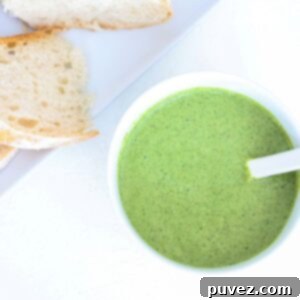
5-Minute Pistachio Pesto
KristiEquipment
-
1 Food processor or blender
Ingredients
- 2 cups fresh basil leaves lightly packed
- ¼ cup pistachios raw or roasted and salted will work
- ¼ cup grated parmesan cheese
- 2 cloves fresh garlic
- 2 tablespoon lemon juice use fresh squeezed lemon juice
- 3 tablespoon extra virgin olive oil
- ⅓ cup warm water
- ½ teaspoon salt sea salt or table salt (adjust to taste based on pistachios)
- ¼ teaspoon black pepper
Instructions
-
Carefully place all the listed ingredients into the bowl of your food processor or blender. For best results, ensure the garlic cloves are closest to the blades to ensure they are finely minced. Add the fresh basil leaves last, on top of the other ingredients, so they are gently incorporated.¼ cup pistachios, ¼ cup grated parmesan cheese, 2 cloves garlic, 2 tablespoon lemon juice, 3 tablespoon olive oil, ⅓ cup warm water, ½ teaspoon salt, ¼ teaspoon black pepper, 2 cups fresh basil leaves
-
Process the ingredients, blending or pulsing, until you achieve your desired consistency. You may prefer a slightly chunkier pesto, or a smooth and creamy sauce. Scrape down the sides of the food processor bowl as needed to ensure all ingredients are thoroughly combined.
Notes
- This pesto might have a slightly gritty texture if made in a food processor, which is perfectly fine for many. For an ultra-smooth consistency, consider finishing it with an immersion blender or transferring it to a high-speed blender for a final pulse.
- If you prefer a thinner pesto for drizzling or mixing, gradually add up to one additional tablespoon of water or olive oil for every quarter cup of pesto. Blend after each addition until you achieve your preferred texture.
- When using an upright blender or food processor, always place the garlic cloves closest to the blades first, followed by other ingredients, and basil leaves last. This ensures proper pulverization of harder ingredients.
- For blenders that use an inverted container, load the basil leaves first (so they are at the bottom when upright) and the garlic cloves last (so they are closest to the blades once inverted for blending).
- Adding fresh lemon zest is an optional step. While it adds aroma, some individuals, including myself, have noted a slight aftertaste in this recipe. If you enjoy it, feel free to add some!
- I found it challenging to source raw pistachios in my local grocery stores, so I tested this recipe with both raw and roasted and salted pistachios. Both yielded excellent results! The only notable difference was a slight variation in the pesto’s color. Use what’s available to you!
